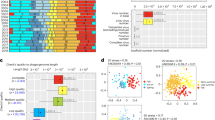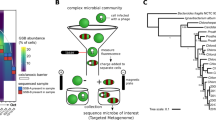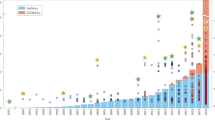Abstract
Recent work has vastly expanded the known viral genomic sequence space, but the seasonal dynamics of viral populations at the genome level remain unexplored. Here we followed the viral community in a freshwater lake for 1 year using genome-resolved viral metagenomics, combined with detailed analyses of the viral community structure, associated bacterial populations and environmental variables. We reconstructed 8950 complete and partial viral genomes, the majority of which were not persistent in the lake throughout the year, but instead continuously succeeded each other. Temporal analysis of 732 viral genus-level clusters demonstrated that one-fifth were undetectable at specific periods of the year. Based on host predictions for a subset of reconstructed viral genomes, we for the first time reveal three distinct patterns of host–pathogen dynamics, where the viruses may peak before, during or after the peak in their host’s abundance, providing new possibilities for modelling of their interactions. Time series metagenomics opens up a new dimension in viral profiling, which is essential to understand the full scale of viral diversity and evolution, and the ecological roles of these important factors in the global ecosystem.
Similar content being viewed by others
Log in or create a free account to read this content
Gain free access to this article, as well as selected content from this journal and more on nature.com
or
References
Bastian M, Heymann S, Jacomy M . (2009). Gephi: an open source software for exploring and manipulating networks. International AAAI Conference on Weblogs and Social Media: San Jose, CA, USA.
Bolduc B, Wirth JF, Mazurie A, Young MJ . (2015). Viral assemblage composition in Yellowstone acidic hot springs assessed by network analysis. ISME J 9: 2162–2177.
Breitbart M, Thompson LR, Suttle CA, Sullivan MB . (2007). Exploring the vast diversity of marine viruses. Oceanography 20: 135–139.
Buntig L, Leavitt PR, Gibson CE, McGee EJ, Hall VA . (2007). Degradation of water quality in Lough Neagh, Northern Ireland, by diffuse nitrogen flux from a phosphorus-rich catchment. Limnol Oceanogr 52: 354–369.
Caporaso JG, Kuczynski J, Stombaugh J, Bittinger K, Bushman FD, Costello EK et al. (2010). QIIME allows analysis of high-throughput community sequencing data. Nat Methods 7: 335–336.
Chow CE, Fuhrman JA . (2012). Seasonality and monthly dynamics of marine myovirus communities. Environ Microbiol 14: 2171–2183.
Correll DL . (1999). Phosphorus: a rate limiting nutrient in surface waters. Poult Sci 78: 674–682.
Cortez MH, Weitz JS . (2014). Coevolution can reverse predator-prey cycles. Proc Natl Acad Sci USA 111: 7486–7491.
Doering PH, Oviatt CA, Nowicki BL, Klos EG, Reed LW . (1995). Phosphorus and nitrogen limitation of primary production in a stimulated estuarine gradient. Mar Ecol Prog Ser 124: 271–287.
Edwards RA, McNair K, Faust K, Raes J, Dutilh BE . (2016). Computational approaches to predict bacteriophage-host relationships. FEMS Microbiol Rev 40: 258–272.
Emerson JB, Thomas BC, Andrade K, Allen EE, Heidelberg KB, Banfield JF . (2012). Dynamic viral populations in hypersaline systems as revealed by metagenomic assembly. Appl Environ Microbial 78: 6309–6320.
Emerson JB, Thomas BC, Andrade K, Heidelberg KB, Banfield JF . (2013). New approaches indicate constant viral diversity despite shifts in assemblage structure in an Australian hypersaline lake. Appl Environ Microbial 79: 6755–6764.
Enright AJ, Van Dongen S, Ouzounis CA . (2002). An efficient algorithm for large-scale detection of protein families. Nucleic Acids Res 30: 1575–1584.
Erez Z, Steinberger-Levy I, Shamir M, Doron S, Stokar-Avihail A, Peleg Y et al. (2017). Communication between viruses guides lysis-lysogeny decisions. Nature 541: 488–493.
Fancello L, Trape S, Robert C, Boyer M, Popgeorgiev N, Raoult D et al. (2013). Viruses in the desert: a metagenomic survey of viral communities in four perennial ponds of the Mauritanian Sahara. ISME J 7: 359–369.
Green JC, Rahman F, Saxton MA, Williamson KE . (2015). Metagenomic assessment of viral diversity in Lake Matoaka, a temperate, eutrophic freshwater lake in southeastern Virginia, USA. Aquat Microb Ecol 75: 117–128.
Holmfeldt K, Solonenko N, Shah M, Corrier K, Riemann L, Verberkmoes NC et al. (2013). Twelve previously unknown phage genera are ubiquitous in global oceans. Proc Natl Acad Sci USA 110: 12798–12803.
Huang X, Madan A . (1999). CAP3: a DNA sequence assembly program. Genome Res. 9: 868–877.
King AMQ, Lefkowitz E, Adams MJ, Carstens EB . (2011) Virus Taxonomy: Ninth Report of the International Committee on Taxonomy of Viruses. Elsevier: Amsterdam, The Netherlands.
Knowles B, Silveira CB, Bailey BA, Barott K, Cantu VA, Cobián-Güemes AG et al. (2016). Lytic to temperate switching of viral communities. Nature 531: 466–470.
Komenda J, Sobotka R . (2016). Cyanobacterial high-light-inducible proteins – protectors of chlorophyll-protein synthesis and assembly. BBA-Bioenerget 1857: 288–295.
Latifi A, Ruiz M, Zhang CC . (2009). Oxidative stress in cyanobacteria. FEMS Microbiol Rev 33: 258–278.
Laybourn-Parry J, Marshall WA, Madan NJ . (2007). Viral dynamics and patterns of lysogeny in saline Antarctic lakes. Polar Biol 30: 351–358.
Li W, Godzik A . (2006). Cd-hit: a fast program for clustering and comparing large sets of protein or nucleotide sequences. Bioinformatics 22: 1658–1659 2006.
Lima-Mendez G, Van Helden J, Toussaint A, Leplae R . (2008). Reticulate representation of evolutionary and functional relationships between phage genomes. Mol Biol Evol 25: 762–777.
Ma Y, Allen LZ, Palenik B . (2014). Diversity and genome dynamics of marine cyanophages using metagenomic analyses. Environ Microbiol Rep 6: 583–594.
Malki K, Kula A, Bruder K, Sible E, Hatzopoulos T, Steidel S et al. (2015). Bacteriophages isolated from Lake Michigan demonstrate broad host-range across several bacterial phyla. Virology J 12: 164.
Maurice CF, Mouillot D, Bettarel Y, Wit RD, Sarmento H, Bouvier T . (2011). Disentangling the relative influence of bacterioplankton phylogeny and metabolism on lysogeny in reservoirs and lagoons. ISME J 5: 831–843.
McDaniel L, Houchin LA, Williamson SJ, Paul JH . (2002). Lysogeny in marine Synechococcus. Nature 415: 2002.
Meyer F, Paarmann D, D’Souza M, Olson R, Glass EM, Kubal M et al. (2008). The metagenomics RAST server – a public resource for the automatic phylogenetic and functional analysis of metagenomes. BMC Bioinform 9: 386.
Noguchi H, Taniguchi T, Itoh T . (2008). MetaGeneAnnotator: detecting species-specific patterns of ribosomal binding site for precise gene prediction in anonymous prokaryotic and phage genomes. DNA Res 15: 387–396.
Overbeek R, Begley T, Butler RM, Choudhuri JV, Chuang HY, Cohoon M et al. (2005). The subsystems approach to genome annotation and its use in the project to annotate 1000 genomes. Nucleic Acids Res 33: 5691–5702.
Paez-Espino D, Eloe-Fadrosh EA, Pavlopoulos GA, Thomas AD, Huntemann M, Mikhailova N et al. (2016). Uncovering Earth’s virome. Nature 536: 425–430.
Palesse S, Colombet J, Pradeep Ram AS, Sime-Ngando T . (2014). Linking host prokaryotic physiology to viral lifestyle dynamics in a temperate freshwater lake (Lake Pavin, France). Microb Ecol 68: 740–750.
Peng Y, Leung HCM, Yiu SM, Chin FYL . (2012). IDBA-UD: a de novo assembler for single-cell and metagenomic sequencing data with highly uneven depth. Bioinformatics 28: 1420–1428.
Peters DL, Lynch KH, Stothard P, Dennis JJ . (2015). The isolation and characterisation of two Stenotrophomonas maltophilia bacteriophages capable of cross-taxonomic order infectivity. BMC Genomics 16: 664.
Rho M, Wu Y, Tang H, Doak TG, Ye Y . (2012). Diverse CRISPRs evolving in human microbiomes. PLoS Genet 8: e1002441.
Popa O, Landan G, Dagan T . (2017). Phylogenomic networks reveal limited phylogenetic range of lateral gene transfer by transduction. ISME J 11: 543–554.
Roux S, Brum JR, Dutilh BE, Sunagawa S, Duhaime MB, Loy A et al. (2016). Ecogenomics and potential biogeochemical impacts of globally abundant ocean viruses. Nature 537: 689–693.
Roux S, Enault F, Robin A, Ravet V, Personnic S, Theil S et al. (2012). Assessing the diversity and specificity of two freshwater viral communities through metagenomics. PLoS ONE 7: e33641.
Roux S, Hallam SJ, Woyke T, Sullivan MB . (2015). Viral dark matter and virus-host interactions resolved from publicly available microbial genomes. eLife 4: 1–20 (2015).
Roux S, Tournayre J, Mahul JA, Debroas D, Enault F . (2014). Metavir 2: new tools for viral metagenome comparison and assembled virome analysis. BMC Bioinform 15: 76.
Skvortsov T, de Leeuwe C, Quinn JP, McGrath JW, Allen CCR, McElarney Y et al. (2016). Metagenomic characterisation of the viral community of Lough Neagh, the largest freshwater lake in Ireland. PLoS ONE 11: e0150361.
Sullivan MJ, Petty NK, Beatson SA . (2011). Easyfig: a genome comparison visualizer. Bioinformatics 27: 1009–1010.
Thingstad TF . (2000). Elements of a theory for the mechanisms controlling abundance, diversity, and biogeochemical role of lytic bacterial viruses in aquatic systems. Limnol Oceanogr 45: 1320–1328.
Tseng CH, Chiang PW, Shiah FK, Chen YL, Liou JR, Hsu TC et al. (2013). Microbial and viral metagenomes of a subtropical freshwater reservoir subject to climatic disturbances. ISME J 7: 2374–2386.
van der Walt S, Colbert SC, Varoquaux G . (2011). The NumPy array: a structure for efficient numerical computation. Compu Sci Eng 13: 22–30.
Wang MN, Ge XY, Wu YQ, Yang XL, Tan B, Zhang YJ et al. (2015). Genetic diversity and temporal dynamics of phytoplankton viruses in East Lake. China Virol Sin 30: 290–300.
Watkins SC, Kuehnle N, Ruggeri CA, Malki K, Bruder K, Elayyan J et al. (2015). Assessment of a metaviromic dataset generated from nearshore Lake Michigan. Mar Freshwater Res 67: 1700–1708.
Wilson WH, Turner S, Mann NH . (1998). Population dynamics of phytoplankton and viruses in a phosphate-limited mesocosm and their effect on DMSP and DMS production. Estuar Coast Shelf Sci 46: 49–59.
Ye J, Coulouris G, Zaretskaya I, Cutcutache I, Rozen S, Madden TL . (2012). Primer-BLAST: a tool to design target-specific primers for polymerase chain reaction. BMC Bioinformatics 13: 134.
Yeo BH, Gin KY . (2015). Population dynamics of cyanomyovirus in a tropical eutrophic reservoir. Microbes Environ 30: 12–20.
Acknowledgements
We thank Dr Catherine Watson and Ms Hanna Cromie for her help with the collection of the samples. The project was funded by Leverhulme Trust Grant RPG-2013-040. BED and KA were supported by the Netherlands Organization for Scientific Research (NWO) Vidi grant 864.14.004. All data will be available from SRA, MetaVir and MG-RAST databases immediately after the publication date (for accession numbers see Supplementary Table 1, sheet 1).
Author contributions
LAK, TS and KA designed the study; TS processed water samples; KA and TS performed bioinformatics analyses of data; KA, TS, JPQ, JWG, CCRA, BED, YM, CW and LAK discussed results and wrote and edited the manuscript.
Author information
Authors and Affiliations
Corresponding author
Ethics declarations
Competing interests
The authors declare no conflict of interest.
Additional information
Supplementary Information accompanies this paper on The ISME Journal website
Supplementary information
Rights and permissions
About this article
Cite this article
Arkhipova, K., Skvortsov, T., Quinn, J. et al. Temporal dynamics of uncultured viruses: a new dimension in viral diversity. ISME J 12, 199–211 (2018). https://doi.org/10.1038/ismej.2017.157
Received:
Revised:
Accepted:
Published:
Issue date:
DOI: https://doi.org/10.1038/ismej.2017.157
This article is cited by
-
Identification and profiling of novel metagenome assembled uncultivated virus genomes from human gut
Virology Journal (2025)
-
Viromics approaches for the study of viral diversity and ecology in microbiomes
Nature Reviews Genetics (2025)
-
Interactions between bacterial and phage communities in natural environments
Nature Reviews Microbiology (2022)
-
Viral diversity is linked to bacterial community composition in alpine stream biofilms
ISME Communications (2022)
-
Host population diversity as a driver of viral infection cycle in wild populations of green sulfur bacteria with long standing virus-host interactions
The ISME Journal (2021)



